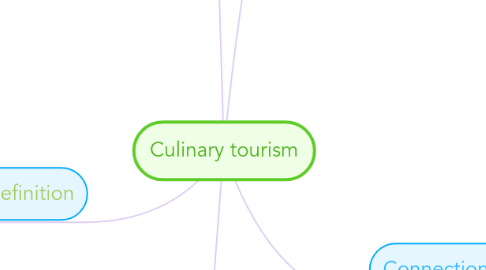
1. Target groups
1.1. food tourists
1.2. wine tourists
1.3. food and wine tourists
1.4. Seeking authenticity of places (UNWTO)
1.5. concerned about the origin of products. (UNWTO)
1.6. Recognize gastronomy as means of socializing, as a space for sharing life with others, for exchanging experiences
1.7. higher-thanaverage expenditure (UNWTO)
1.8. demanding and appreciative (UNWTO)
1.9. Millenials (Ontario)
2. Trends
2.1. food trucks / foodmarkets / food festivals
2.2. Growing market (UNWTO)
2.3. the conversion of the territory into a culinary landscape is one of the challenges of tourism destinations. (UNWTO)
2.4. Sustainability
3. Definition
3.1. Developed by Lucy Long in 1998 (Wolf, 2012)
3.2. Experience and accept different culture without reluctance (Long 2004)
3.3. Part of cultural tourism?
3.3.1. Cultural tourists are usually interested in products and culture of a specific destination as well as learning about a culture (Richards 1996)
3.4. Other words used: Food tourism, gastronomy tourism
3.5. The intentional, exploratory participation in the foodways of an other – participation including the consumption, preparation, and presentation of a food item, cuisine, meal system, or eating style considered to a culinary system not one’s own (Long, 2004).
3.6. Culinary tourism or food tourism?
3.6.1. Culinary might give a misleading impression, "culinary" might sound more for elitist (WFTA)
3.7. Far and near (WFTA)
3.8. food tourism is an experiential trip to a gastronomic region, for recreational or entertainment purposes, which includes visits to primary and secondary producers of food, gastronomic festivals, food fairs, events, farmers’ markets, cooking shows and demonstrations, tastings of quality food products or any tourism activity related to food. (Hall and Sharples (2003)
3.9. attracting visitors to participate in the destination’s own cultural reality, well explained and interpreted, through cuisine, local products and all the services and activities that surround them.
4. Destination management
4.1. increasing interest in local cuisine (Sharim ab Karim)
4.1.1. adding value to agricultural products (du Rand)
4.2. Improtant for marketeers to know current image and how this can be influenced (Sharib ab Karim)
4.2.1. enhancing local identity for destination marketing (du Rand)
4.3. destinations can use food to represent its “cultural experience, status, cultural identity, and communicating” (Frochot 2003)
4.3.1. Could play a keyrole in attracting visitors
4.4. Food should be part of the social culture that creates a national identity (Riley 2000)
4.5. Local experience
4.5.1. enhance existing tourism products (du Rand)
4.5.2. only experience which enhaces all human senses(du Rand)
4.5.3. providing theme to build up attractions (du Rand)
4.6. foods either constitute an event attraction or act as the gastronomic part of the attractions in destinations. The gastronomic experience could become a major, or one of major motivations, for travel (Quan & Wang)
4.7. tourists seek new and authentic experiences and alternative forms of tourism (Boyne et ah, 2003; Crouch & Ritchie, 1999; Hjalaeer & Richards, 2002; Selwood, 2003).
4.8. Destinations must articulate a credible and authentic narrative of their food tourism offerings. (UNWTO) there should be cooperation between stakeholders
5. Connection food- tourism
5.1. everyone needs to eat (Sharim ab Karim)
5.2. 40% of budget by tourist spend on food (Sharib ab Karim)
5.3. 50% of restaurants' revenue generated by tourists (Sharib ab Karim)
5.4. Authentic and interesting food can attract visitors (Sharib ab Karim)
5.5. Food can be most memorable part of the trip (Quan and Wang 2004)
5.6. Food is often part of culture (Ching Shu Su)
5.6.1. prominent point of cultural differences
5.6.2. Sometimes specific foods are connected to a certain culture e.g. pasta to Italy (du Rand)
5.6.3. Cultural identity (Delamont, 1994)
